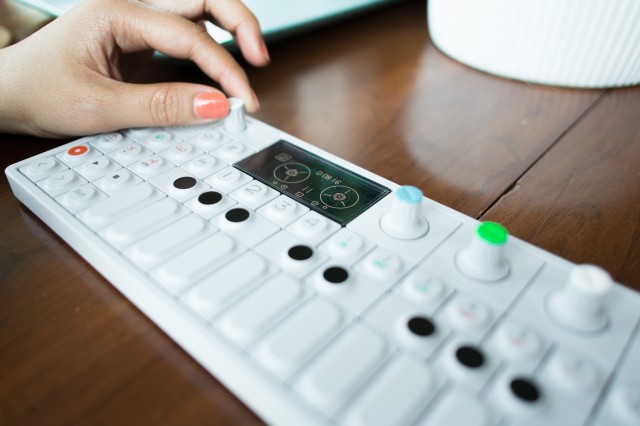
This time last year, I walked into a Toronto store called Moog Audio and walked out with a Teenage Engineering OP-1—a curious little portable digital synthesizer that looks, at first glance, like a child’s toy. It has a row of just four candy-colored knobs as primary input controls, and there are only enough keys for an octave-and-a-half's worth of range. But damn does it ever sound cool. Its tiny OLED screen uses all sorts of clever visual conceits to convey otherwise complex audio transformations. Colors and animations explain the differences between synthesizer engines, changes to modulation and frequency, and attack and decay. And it's done in a way that’s easy for anyone with little synthesizer knowledge to understand while still being powerful in more experienced hands. This is a synthesizer, drum machine, and four-track recorder all-in-one—all in a device that fits inside a purse or messenger bag with ease.
It wasn’t always like this. In fact, it was 50 years ago this year that, in 1964, a man by the name of Bob Moog unveiled a synthesizer of a very different sort. Called the Moog Modular, it is regarded as one of the first. Though Moog wouldn’t officially advertise his creation as a synthesizer until 1966, that’s precisely what it was—an array of electronic modules that Moog designed, often controlled via keyboard, and connected to one another with a bird's nest of cables that, somehow, produced weird musical sounds unlike anything anyone had heard before.
The Moog Modular was not the only synthesizer in development at the time, however. On the opposite end of the continent in Berkeley, California, a man named Don Buchla independently devised a similar device, but it differed in a crucial way. Buchla’s synthesizer eschewed the use of a keyboard to trigger notes for touch-controlled panels that produced unfamiliar, atonal music unbound from the traditional musical scale. Both had their proponents, but for most musicians, the familiarity of the keyboard paradigm eventually won out. For a time, Moog was synthesizers. Even today, it’s a testament to the enduring cachet of Moog’s work that one can now buy any number of competing synthesizers from a store bearing his name.
My OP-1 is tiny compared to the size of Moog’s first synthesizer, yet it's far more powerful than anyone, even Moog, could have imagined. But today's marvels wouldn’t exist were it not for his (and Buchla’s) work. Even beyond the instrument, many of the things we take for granted—from the sound cards in our computers, to some of Hollywood’s most iconic films—were created, in part, thanks to Moog’s first modular synth.
Sounds that go wooo
Born in 1934 to George and Shirley Moog, a young Bob Moog first learned to build electronics in the family’s basement with his father, a Con Edison electrical engineer. According to Trevor Pinch and Frank Trocco’s 2002 book Analog Days: The Invention and Impact of The Moog Synthesizer, Moog became particularly enamored with a hobbyist kit for a strange device called the Theremin. He built his first at the age of 15.
Some like to refer to the Theremin as the first electronic instrument. Lev Termen (or Léon Theremin), the Russian inventor after which the Theremin is named, invented the device in the early 1920s. It has two metal antennas that, based on the position of a person’s hands above the device, control the volume and pitch of an oscillator. In other words, the Theremin is played, not with any physical controls, but by waving your hands around in the air. The result is… weird. If you don’t know what it sounds like, enjoy the below video from YouTube. The high-pitched, voice-like wail produced by the Theremin sounds like something from another world—which is probably why it was so often used in early Hollywood films to signify the alien, mysterious, and strange.
As Moog’s Theremin hobbyist skills improved, he formed the R. A. Moog Co. with his father. The pair began by selling Theremin parts, and later, the instruments themselves, both as fully completed models and kits. This continued through 1957 during Moog's time at Columbia University and Queens College, where he earned an undergraduate degree in physics and a master's degree in electrical engineering, and into 1958, when Moog began graduate studies at Cornell University. In 1963, Moog moved his business from the basement of his house to a storefront in Trumansburg, just north of Ithaca. He intended to become a fully fledged manufacturer of Theremin kits.
At least, that was the plan until Moog met a young experimental music composer named Herbert Deutsch.
According to Analog Days, Deutsch first met Moog at a conference in 1963, where Moog was selling his company’s newly manufactured Theremin kits. Deutsch liked the Theremin, but what he really wanted was an instrument that would allow Deutsch to make “sounds with moving pitches,” according to Moog (or, as Deutsch is reported to have said, “sounds that go wooo-wooo-ah-woo-woo.”) Moog was always attentive to the needs of musicians throughout his career, so he started work on the device Deutsch described.
The following year, at a talk in October 1964, Moog presented his initial result in a paper for The Audio Engineering Society titled “Voltage-Controlled Electronic Music Modules.” It described “the first results of a program directed toward the development of a system for the composition of electronic music.”
It was one of the very first synths.
reader comments
178